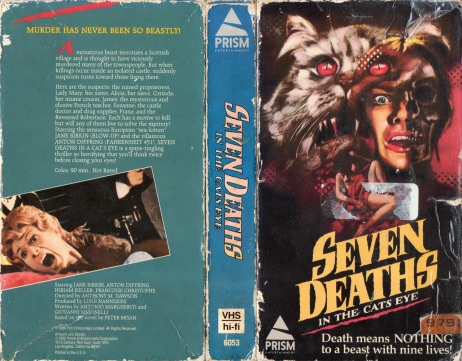The plot, such as it is, concerns an aristocratic family who live in a crumbling, rat-infested castle, and who allegedly turn into vampires when murdered. That legend is about to be put to the test, as several family members, associates and pet gorillas are mercilessly slaughtered by an unknown killer, with an inheritance scheme ultimately revealed to be driving the plot. At the centre of it all is Corringa (Jane Birkin), a schoolgirl who surprises her mother and aunt by arriving unexpectedly early to her aunt's castle (she's been expelled from school for being naughty and visiting boys), and her cousin James, Lord of the Castle (Hiram Keller), who stalks about the place using secret passages, and wallowing in his apparent madness.
This madness supposedly led to him murdering his baby sister as a child, although we later discover that he is in fact innocent of this crime, and may have been conditioned into thinking that he's insane. At least he has this induced madness to fall back on by way of explanation when he and his cousin start an illicit affair; she has no such excuse. The film is full of secret affairs, secret passages and secret gorillas. Oh, and the titular cat, who creeps about the castle in a James-esque manner, and always manages to be present whenever the murderer is doing their dirty work. The cat puts in a solid performance, leaving Gainsbourg, for one, trailing in his wake.
As you've probably gathered from the above, this film's as mad as Lord James. Margheriti gets a co-writer credit, which I wouldn't be surprised to discover was derived solely as a result of his freestyling on the set. He throws in some arty shot-from-above compositions and Bava-esque gel lighting too, whenever the scene threatens to become too mundane. The film's supposedly adapted from a novel by Peter Bryan, but this seems like a made-up credit. It does play like a quasi-remake of Top Sensation at times, with the action set almost exclusively in a castle rather than upon a boat. The domineering mother figure, maladjusted man-child, cynical family 'friend' and spurned prostitute figure all recur, as does the 'pure' love between the man-child and a sweet young woman (Top Sensation does steer clear of the incest angle, but replaces it with a bestiality one).
Seven Deaths is often described as a gothic giallo. This is true, but it doesn't really have much in common with Gothic cinema of the 60s and 70s, of which Margheriti was a leading proponent. The ingredients are there-large castle, graveyard, crypt, gorilla suit-but they're served up in a manner that generates an atmosphere of insanity more than an atmosphere of creepiness (creepy incest aside). This does tie in neatly with the supposed Madness of Lord James, although I doubt Margheriti rationalised his approach to such an extent.
|
The film more closely resembles Gothic literature of the late eighteenth and early nineteenth centuries, which adopted a similar throw-everything-at-the-old-crumbling-wall-and-see-what-sticks approach. It makes for a great fun watch, although anyone expecting a tightly-wound plot, or extravagant gore effects, will be disappointed. Margheriti never had the flair for, or interest in, OTT violence which was possessed by Bava and Argento (Cannibal Apocalypse being an exception, though by all accounts that film's gore is entirely down the Giannetto de Rossi's influence), and his plots, although occasionally intricate, usually served as a mechanism through which he could showcase his visual inventiveness and general sense of fun. This film's no different. Its giallo attributes are many, albeit rarely rising above box-ticking. but if you're willing to sit back and let the film wash over you, you'll be swept along on a deliriously fun 94 minute ride.
|

 RSS Feed
RSS Feed
